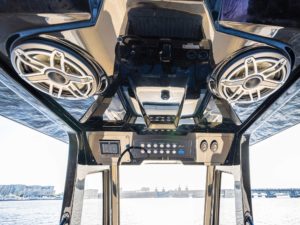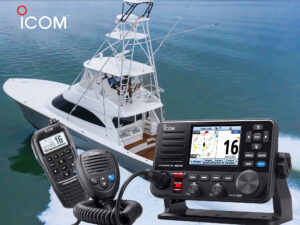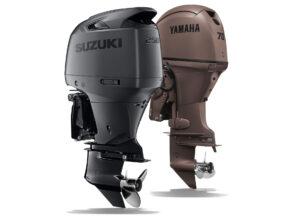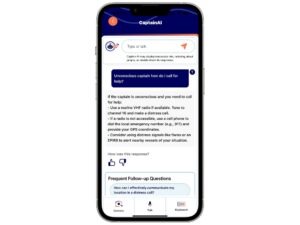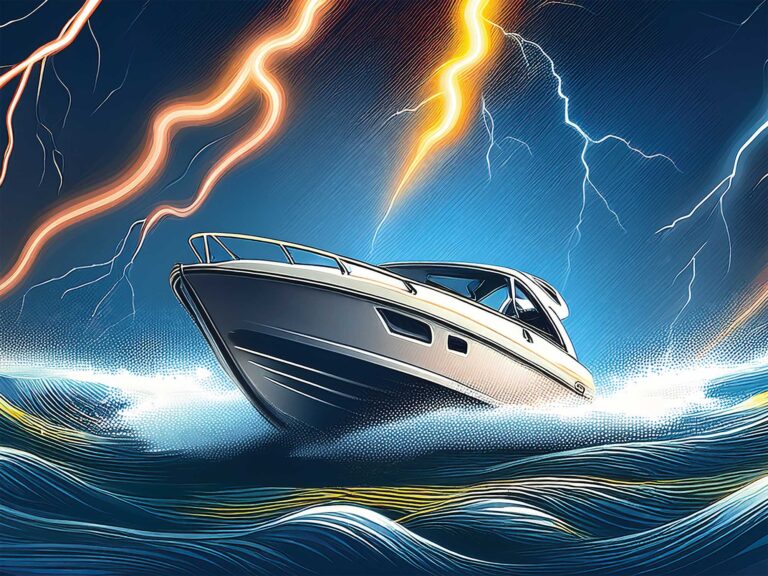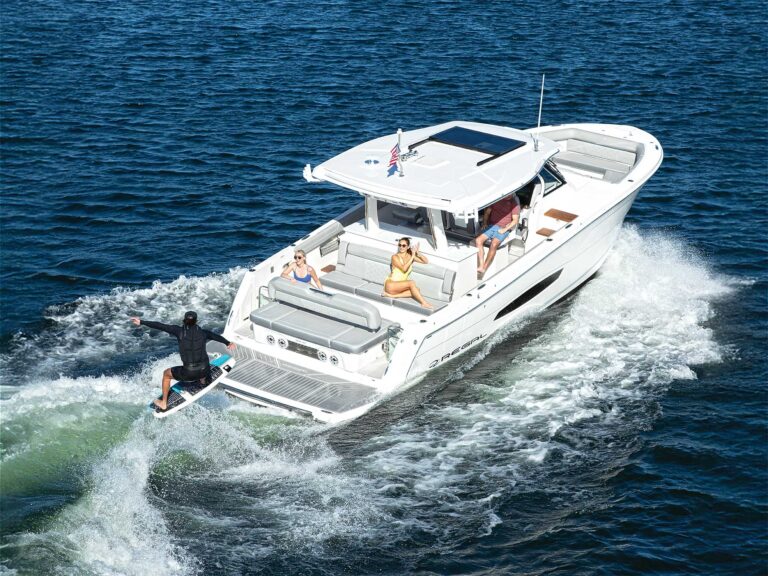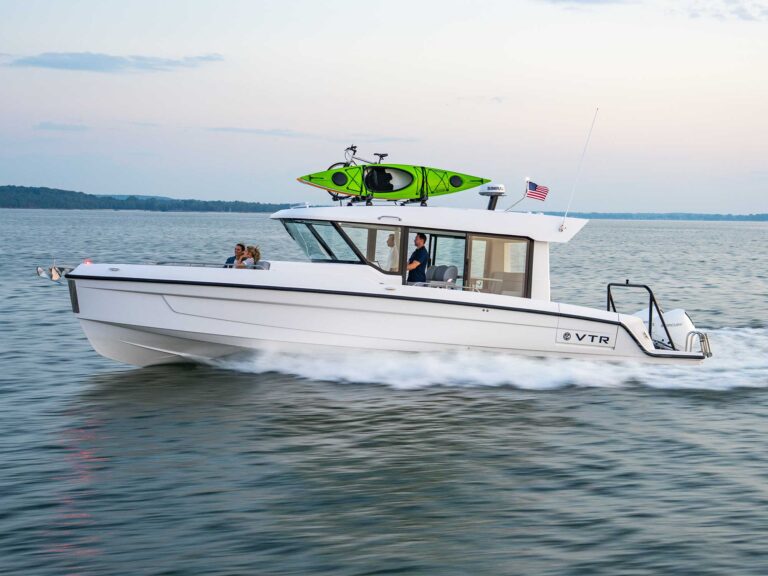
Repowering an outboard-powered boat is like playing with Lego bricks. You pop off the old outboard and snap the new one into place. But when your sterndrive engine expires, you might find yourself standing in the cockpit, staring down at an open engine hatch wondering, Now what? What is this going to cost, and will this engine even come out of the boat? Instead of Legos, this seems more like open-heart surgery.
Fear not, sterndrive owner. The skills of a heart surgeon—or their income—are not required to get a sterndrive boat repowered and back on the water. There is no question this can be a more complex project than hanging a new outboard, but the result can provide a real upgrade in performance and reliability for a fraction of the cost of a new boat.

Making It New Again
For boat-owner Tim Ferguson, when the starboard sterndrive engine of his 1998 Cruisers Yachts 2870 Rogue expired after about 460 hours of operation, the cost of repowering was concerning, but not top of mind.
“This is the first and only boat we’ve owned,” says Ferguson, a senior IT manager from Dale, Wisconsin, who purchased the Cruisers in 2007. “It has huge sentimental value to the family. Our kids essentially grew up on this boat. My wife and I are now empty nesters, and it’s perfect for just the two of us.”
That sentimental attachment is probably the No. 1 reason most people choose to take on a repower project, and in this case, those emotions were backed by sound financial reasoning. The Cruisers 2870 was a well-made boat when it was new, and the brand has a good pedigree.
“Other than the engines, the boat was in really good condition,” Ferguson says. “It had a sound transom and stringers, and everything else worked well and looked good. We briefly considered purchasing a new boat, but the cost to replace the Cruisers convinced me to take a hard look at repower.”
Because he bought the boat used, Ferguson has less than the full suggested retail invested in this Cruisers Yachts from the start, and replacement options range in price from about $135,000 for a new 28-foot Four Winns Vista 275 to $338,000 for a 31-foot Formula 310 Sun Sport. I found a few used Cruisers 2870 boats for sale online, ranging in price from about $36,000 to $40,000, with plenty of hours on the engines. So, spending $35,000 to repower this twin-engine boat with brand-new engines and drives does not seem like a bad investment.
There’s another repower bonus: upgrading the performance and technology. Most examples of the Cruisers 2870 Express went out the factory door powered by twin 220 hp MerCruiser 5.0-liter V-8 engines with Alpha One sterndrives. If you think 440 hp seems marginal for a 10,000-pound (dry) boat, we agree. Taking on the repower project gave Ferguson the opportunity to upgrade to a pair of 5.7-liter 300 hp MerCruiser 350 MPI V-8 engines, which feature multipoint fuel injection for much-improved starting, fuel economy and smoother operation than the original-equipment carburetors. Fuel injection is also more resistant to ethanol-related issues that plague carbureted engines.
Ferguson had the work done at Lakeside Marina in Oshkosh, Wisconsin, working with service consultant Tom Smock and technician Dan Jansen to devise the repower plan. Ferguson considered engine options from Mercury Marine, Quicksilver and a Wisconsin shop selling remanufactured long-block marine engines. They settled on Plus Series remanufactured complete engines from Mercury Marine, new MerCruiser Alpha One drives from Mercury, and new Quicksilver transom assemblies (which include the gimbal housing, rear engine mount, trim rams and more). Upgrading to MerCruiser Bravo drives would have doubled the cost of those components—too big a blow to this project’s budget. Note that Mercury Marine offers up to $50,000 in repower financing. There are aftermarket options as well. Sterndrive Engineering Inc. sells a complete drive to replace an Alpha for $1,655 and the transom assembly for $1,725, with a three-year warranty.

Jansen has 18 years of experience as a marine tech and has done a number of sterndrive-repower jobs. As with an outboard repower, boat integrity is key, so his first step is always an inspection of the transom, stringers and engine mounts, all of which can be repaired but at significant cost. A concern that never comes up with an outboard repower is the task of removing the engines from the boat. Most builders—but not all—take this into account when designing the engine hatches and surrounding deck. Jansen recalls one sterndrive-repower project that required cutting away a portion of the deck to remove the engines. Jansen was able to get the engines in and out of the Cruisers 2870, but it was an operation that required some precision. I was on hand when the starboard engine was installed using a chain hoist and a large fork lift. Jansen had to lower the engine through the hatch sideways and then turn it 90 degrees once it was below the deck level. There was less than an inch to spare, and the operation was further complicated by the position of the sport arch over the engine-hatch area.

Installing the first engine was not much trouble, but the second engine was a much more physically demanding challenge because there is just a few inches between the two engines, which had Jansen wiggling around in the bilge to reach engine-mount bolts. In fact, he owns a special “stubby” Snap-On wrench he uses only for reaching and tightening these mount bolts. A single-engine installation is obviously often a little easier.
Ferguson says he’s still working on propping, but already the performance gain is significant.
“The engines start instantly; hard starting was becoming more and more of a problem with the old engines,” he says. “When we got the boat, it would top out at about 41 mph but, after 14 years, top speed was down to 37 mph, and the boat struggled to plane with a heavy load of guests. Now it pops right on plane, and we are already seeing 45 mph using the old props. It will only get better.”

While the boat was in the shop, Ferguson had an extended swim platform and new cockpit carpet installed, added a Garmin multifunction display to the helm, and installed a Mercury VesselView Link engine display, which he wirelessly connects to an iPad to monitor engine vitals. This past summer, Lakeside installed cabin air conditioning. The result? This boat is better than new.
Thinking of taking on a repower project? Here are some questions you might want answered.
Can I Switch Brands?
Fancy replacing your MerCruiser with a Volvo Penta, or vice versa? It can be done. Volvo SX drives made since 1994 and Volvo Duoprop drives made since 1996 use the same transom cutout as MerCruiser drives, although some techs we spoke to say that going from Volvo Penta to MerCruiser can still result in a leaky transom. Volvo has no program to sell new or remanufactured legacy engines, so you’d need to buy a current model with ETC to get a brand-new Volvo engine (figure about $30,000 for a 5.3-liter Volvo V-8-300-C with an SX drive). Quicksilver offers long blocks and some complete engines that will mate to a Volvo drive. Swapping brands also might require new controls, instruments and a wiring harness. Another option could be Ilmor, which, through its dealers, offers small-block and big-block catalyzed engines from 365 to 483 hp. An Ilmor engine can be mated to its One Drive or to a MerCruiser Bravo drive. The One Drive cutout is slightly different from what’s required for a MerCruiser, but it is workable, according to Ilmor.

What Are My Engine Options?
Complete Engine: This is a complete, all-new engine top to bottom, ready to drop into your boat, either a current MerCruiser or Volvo Penta engine, or a legacy pre-emissions control technology engine. The Quicksilver division of Mercury Marine might be the biggest manufacturer of new marine engines intended specifically for repower in pre-ECT boats, from 3.0- to 8.1-liter displacement. All except 3.0-liter models are fuel-injected and come with a three-year warranty.
Remanufactured Engine: A “reman” is a used engine that is disassembled and then rebuilt. Parts that are in good condition are reused; those that are not are replaced with either good used parts or new parts. Dress components—exhaust manifolds, alternator, ignition, fuel system and more—are replaced with new parts. These engines typically have a one-year warranty and cost several thousand dollars less than an all-new engine.
Crate Engine: If the engine to be repaired has internal damage but the dress components are in good condition, a crate engine might be an option to consider. A crate engine is a major assembly—either all-new or reman—that includes a new long block as well as the fuel-delivery and ignition components. The engine is completed by reusing many dress components from the engine being repaired, or those components must be purchased separately. These might include engine mounts, the fuel-handling system, exhaust system, starter, alternator, seawater pump and power steering. Installing these components adds to the labor cost of a repower project, but it also makes the engine adaptable to either MerCruiser or Volvo Penta installations.
Read Next: Seven Engine Repowering Tips
Long Block: A long block is an engine—new or reman—without dress components (alternator, water pump, etc.), or the exhaust or fuel system. A long block might be an option to consider if the original engine has a cracked block but low hours, if the exhaust is free of corrosion, and if the fuel system is in good shape because you’ll want to reuse those parts. Removing and reinstalling all those components adds to the labor expense, but an all-new Quicksilver 5.7-liter long block is only $6,269.

Essential Alignment
Engine alignment with the transom is absolutely key, according to Jansen, who says he has spent hours getting that alignment just right—using a special Mercury tool that slides through the transom to the end of the engine-output shaft, and climbing in and out of the boat when nobody’s around to help—to bump the engine a fraction of an inch this way or that on the mounts.
“I know that if I don’t get the alignment right, I’ll have to pull these motors again in 40 hours to replace the rubber drive-shaft coupler,” Jansen says. “Mercury says you should be able to slide the alignment tool in and out using just your fingertips. It takes some patience.”
Cost Breakdown
- Two MerCruiser 350 MPI 300 hp reman engines: $22,638.32
- Labor to install and test engines: $2,391
- Two new Mercury Alpha One drives: $6,671
- Two new Quicksilver transom assemblies: $4,736
- Two MerCathode units: $346.50
- Labor to install transom assemblies and drives: $1,155
- Miscellaneous parts required to complete the installation (gear lube, filters, hoses, etc.): $500
- Total: $34,438
Know the Law
Emission control technology, in the form of exhaust catalysts, has been required on sterndrive engines in new boats sold in California since 2008, and since 2010 in the other 49 states. If you use a new engine to repower a boat built since either of those dates, you must use an engine equipped with ECT. You may repower an older boat with a new non-ECT engine, but the engine you remove from the boat must be returned to the engine builder, which will scrap the engine and certify to the federal Environmental Protection Agency that the engine is out of circulation. If you repower with a remanufactured engine, no return is required. Thinking about installing a current MerCruiser or Volvo Penta engine in your older boat, maybe to get digital controls and lower emissions? Measure carefully. Most current-model engines are physically larger than pre-ECT engines and might not fit in the engine bay.

